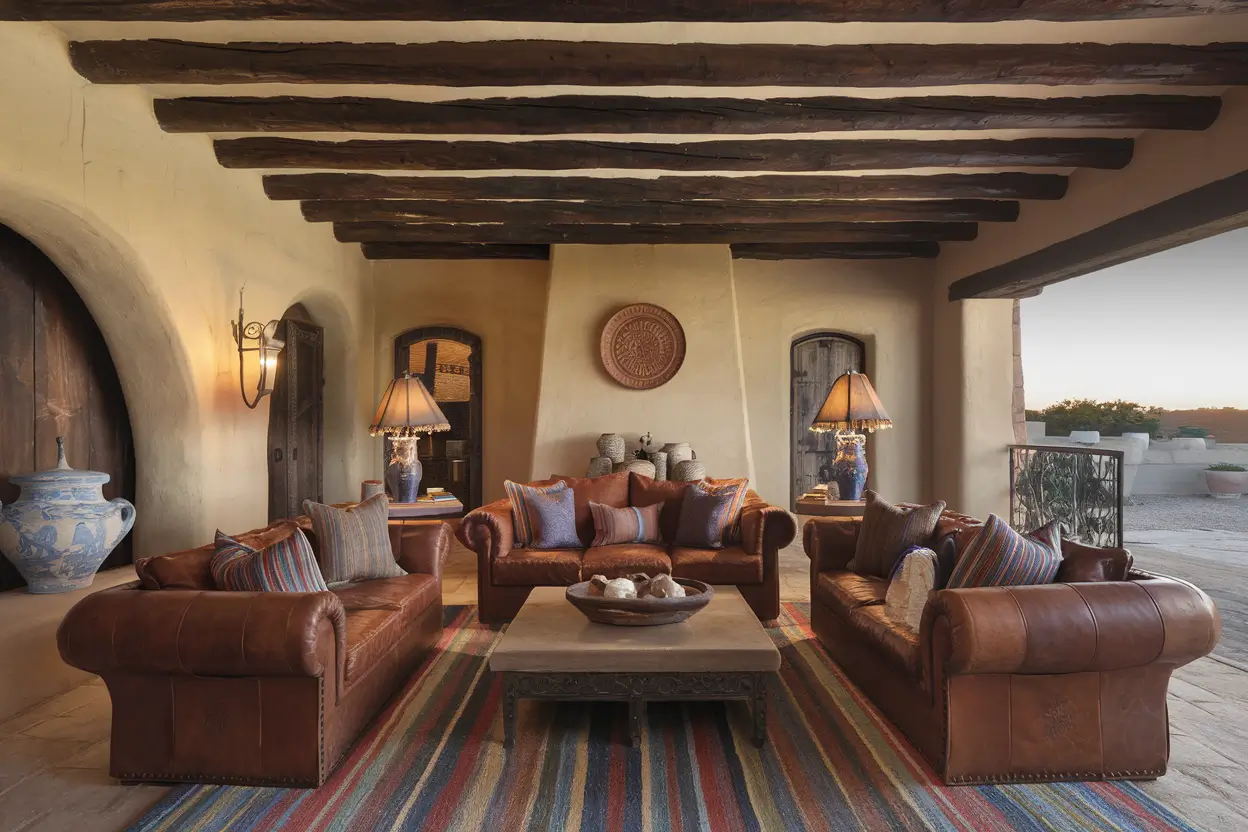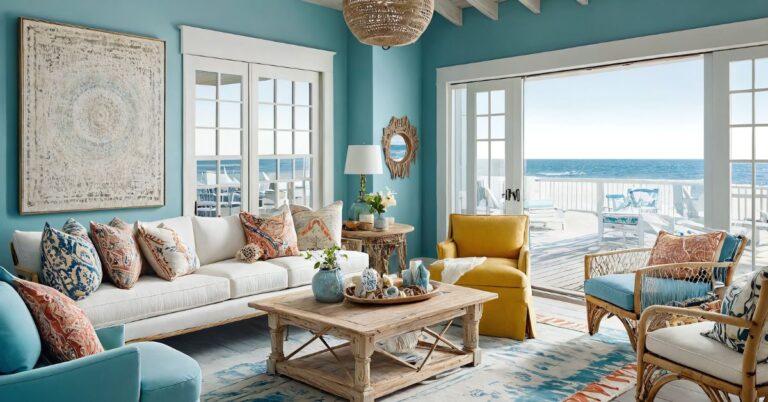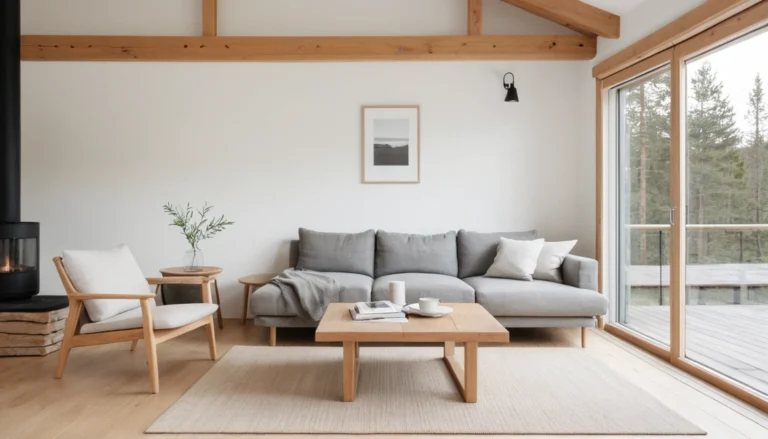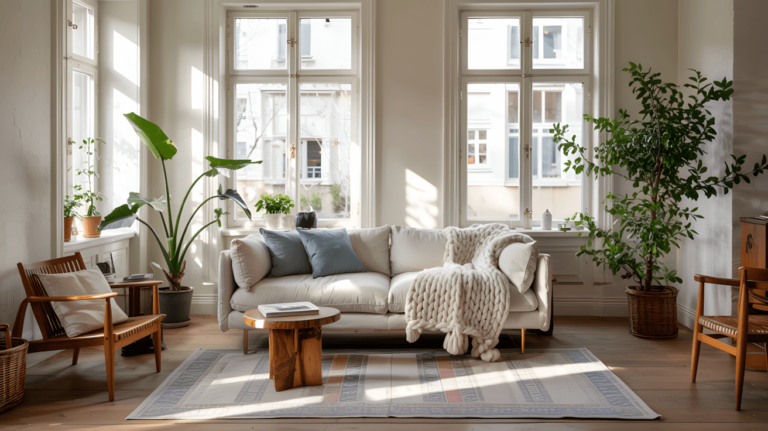You walk into a friend’s home and immediately feel transported to a cozy hacienda in Guadalajara.
The warm terracotta walls seem to glow in the afternoon light, hand-painted Talavera tiles catch your eye from the kitchen backsplash, and the scent of cinnamon and vanilla candles mingles with the earthy aroma of leather furniture.
This isn’t just decoration—it’s cultural storytelling through design.
If you’ve been craving a home that feels authentic, warm, and bursting with personality, rustic Mexican décor offers the perfect antidote to sterile, cookie-cutter interiors.
Over the past decade working with homeowners who want to infuse their spaces with genuine Mexican artistry, I’ve discovered that this style isn’t just about adding a few colorful accents—it’s about creating an atmosphere that celebrates craftsmanship, family traditions, and the natural beauty of handmade objects.
In this comprehensive guide, you’ll discover 25 carefully curated rustic Mexican décor ideas that range from simple weekend updates to transformative room makeovers.
Whether you’re working with a modest budget or ready to invest in authentic pieces, these ideas will help you create a home that feels both sophisticated and soulful.
Understanding Authentic Rustic Mexican Style
Before diving into specific décor ideas, it’s crucial to understand what makes Mexican rustic design authentic rather than clichéd.
True rustic Mexican style emerged from the fusion of indigenous craftsmanship with Spanish colonial influences, creating a design aesthetic that celebrates both functionality and beauty.
The foundation of this style rests on three core principles: natural materials, handcrafted artistry, and earthy color palettes.
Unlike mass-produced interpretations you might find in big-box stores, authentic Mexican rustic décor emphasizes imperfection as beauty—the slightly uneven edges of hand-thrown pottery, the natural variations in reclaimed wood, and the subtle color differences in hand-woven textiles.
What I’ve learned from visiting artisan workshops across Mexico is that every piece tells a story. The blue and white Talavera pottery from Puebla carries techniques passed down through generations, while Oaxacan textiles reflect indigenous weaving traditions that predate Spanish colonization.
When you incorporate these elements into your home, you’re not just decorating—you’re preserving cultural heritage.
Foundation Elements: Setting Your Base
1. Adobe-Inspired Wall Textures
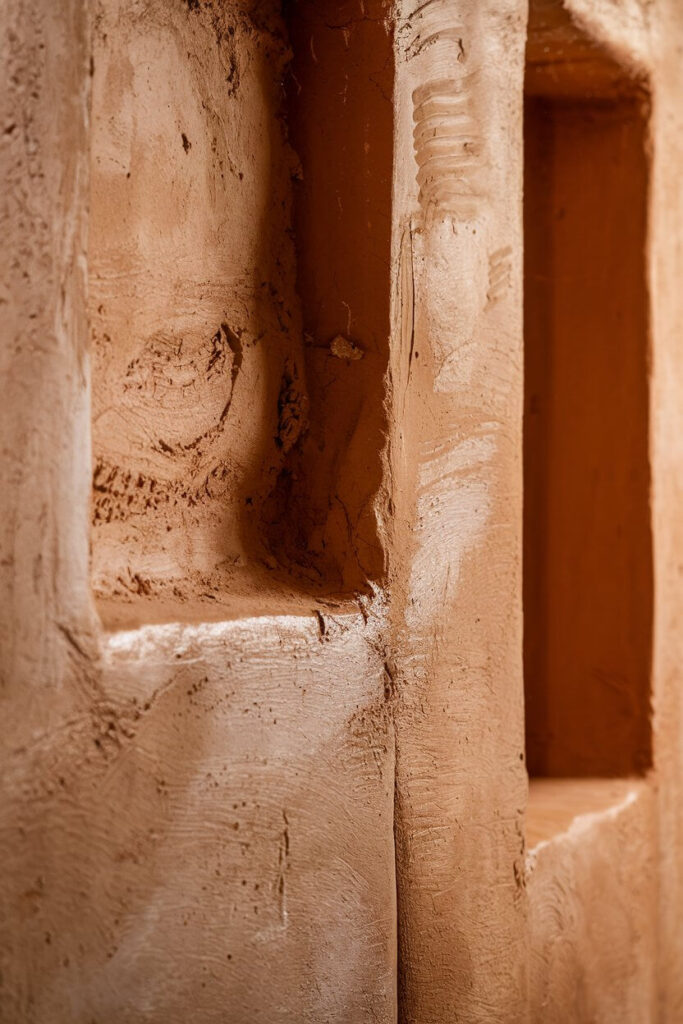
Transform flat drywall into something that feels authentically southwestern by applying texture techniques that mimic traditional adobe construction.
Start with a base coat of warm beige or soft terracotta paint, then use a natural sea sponge to dab on slightly darker and lighter tones in random patterns.
Why it works: This technique creates depth and visual interest while providing the perfect backdrop for other Mexican décor elements. The subtle texture catches light beautifully throughout the day.
Best for: Living rooms, dining areas, and entryways where you want to make a strong first impression.
Pro tip: Work in small sections while the paint is still slightly wet, and don’t aim for perfection—irregularity is what makes it look authentic.
Potential drawback: This technique can make small rooms feel even smaller, so consider using it as an accent wall in compact spaces.
2. Saltillo Tile Flooring
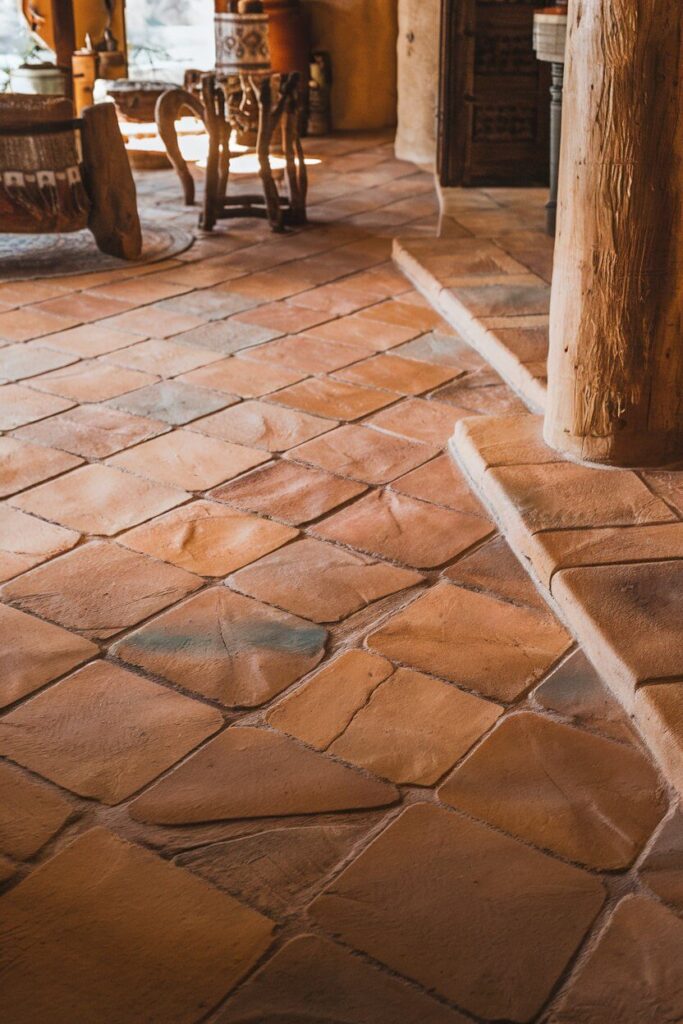
Nothing captures the essence of a Mexican hacienda quite like authentic Saltillo tiles. These handmade terracotta tiles from Saltillo, Mexico, feature natural variations in color and slight surface imperfections that machine-made tiles simply can’t replicate.
Why it works: The earthy tones complement virtually any color scheme while providing a durable, practical flooring solution that actually improves with age.
Best for: Kitchens, bathrooms, entryways, and patios where you want authentic Mexican character with easy maintenance.
Pro implementation tip: Seal your Saltillo tiles properly with a penetrating sealer to prevent staining while maintaining their natural matte finish.
Potential drawback: Initial installation costs can be higher than ceramic alternatives, and the tiles require periodic resealing.
3. Vigas and Corbels Ceiling Treatment
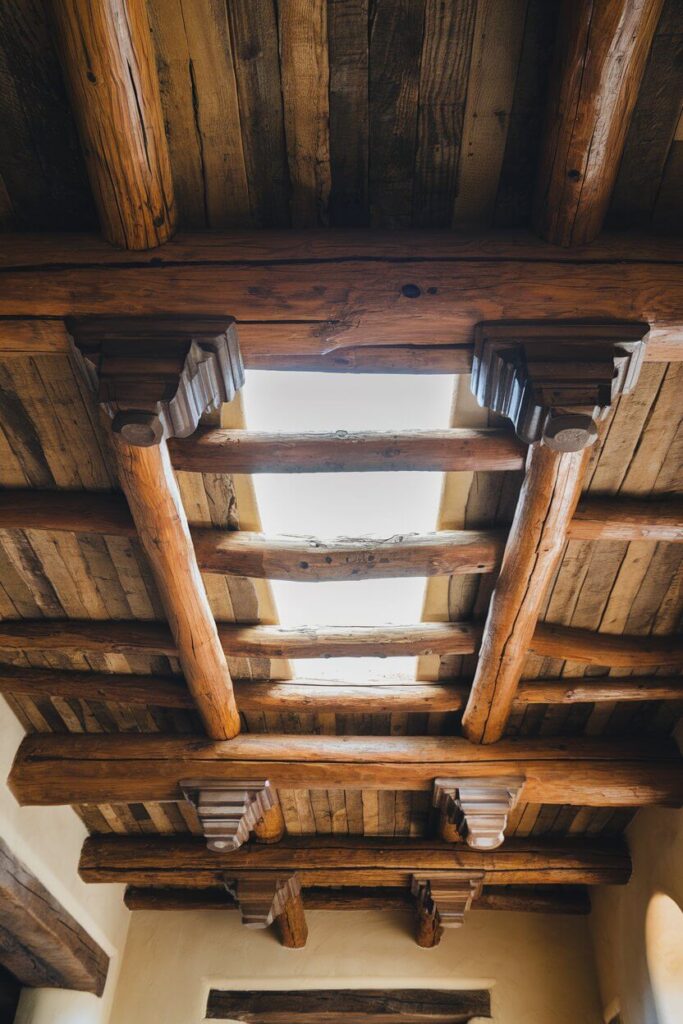
Exposed wooden beams (vigas) supported by decorative brackets (corbels) instantly transform any room into a Mexican-inspired space.
If your home doesn’t have structural beams, faux vigas made from lightweight polyurethane can provide the same visual impact.
Why it works: This architectural element adds rustic charm while creating the illusion of higher ceilings and more spacious rooms.
Best for: Living rooms, dining rooms, and master bedrooms where you want to create a dramatic focal point.
Pro implementation tip: Paint the ceiling between beams in a slightly darker shade than your walls to create depth and prevent the space from feeling overwhelming.
Potential drawback: In homes with low ceilings, this treatment can make rooms feel cramped rather than cozy.
4. Natural Stone Accents
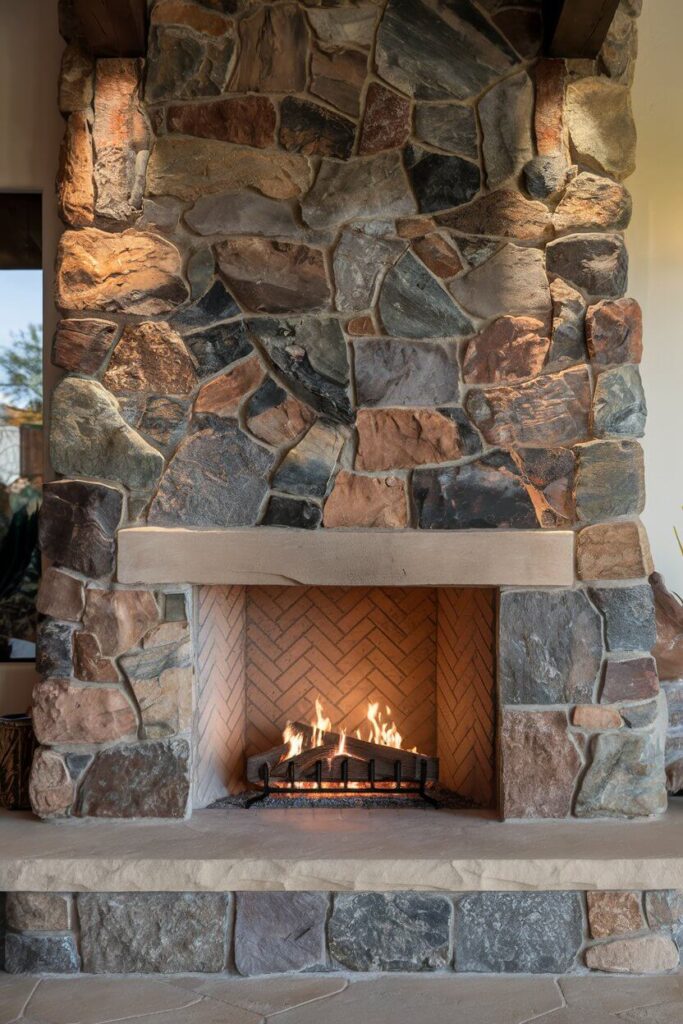
Incorporate natural stone elements like river rock, limestone, or volcanic stone to add authentic texture and earthiness. Consider creating a stone accent wall behind a fireplace or using natural stone for a kitchen backsplash.
Why it works: Stone provides a beautiful contrast to smooth surfaces while connecting your interior to the natural landscape that inspired traditional Mexican architecture.
Best for: Fireplaces, kitchen backsplashes, bathroom vanity surrounds, and outdoor living spaces.
Pro implementation tip: Mix different sizes and shapes of the same stone type for the most natural appearance, and avoid perfectly uniform installations.
Potential drawback: Natural stone requires more maintenance than manufactured alternatives and can be cold underfoot in bathrooms.
5. Wrought Iron Architectural Details
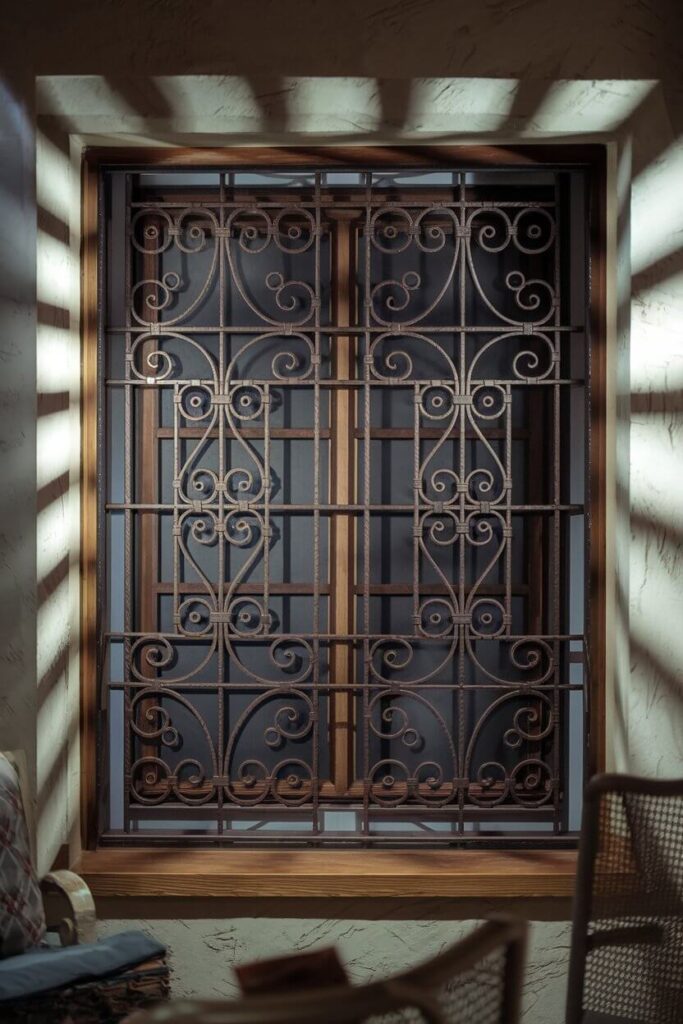
Hand-forged wrought iron elements like window grilles, stair railings, and decorative brackets add authentic Mexican character while serving functional purposes. Look for pieces with traditional scrollwork patterns or geometric designs.
Why it works: Wrought iron provides beautiful contrast against adobe-style walls while adding security and architectural interest.
Best for: Windows, staircases, balconies, and as decorative wall elements in conjunction with other rustic materials.
Pro implementation tip: Apply a rust-resistant coating annually in humid climates to maintain the iron’s appearance and structural integrity.
Potential drawback: Authentic wrought iron can be expensive and may require custom fabrication for proper fit.
6. Reclaimed Wood Features
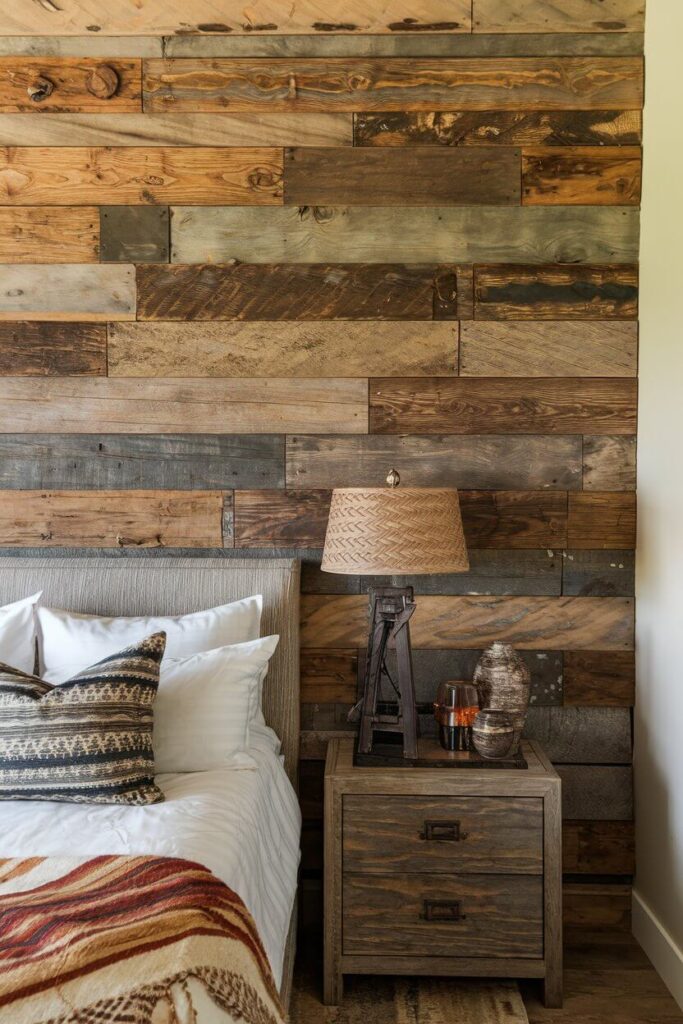
Incorporate weathered, reclaimed wood through ceiling beams, accent walls, or furniture pieces. The patina and character marks from decades of use add instant authenticity that new wood simply cannot match.
Why it works: Reclaimed wood brings history and character to modern homes while supporting sustainable design practices.
Best for: Accent walls, floating shelves, dining tables, and custom cabinetry where you want to showcase natural wood grain.
Pro implementation tip: Source reclaimed wood from reputable dealers who can verify its history and ensure it’s been properly treated for indoor use.
Potential drawback: Reclaimed wood can be more expensive than new lumber and may contain hidden nails or hardware that complicate installation.
Textiles and Soft Furnishings
7. Authentic Serape Throw Blankets
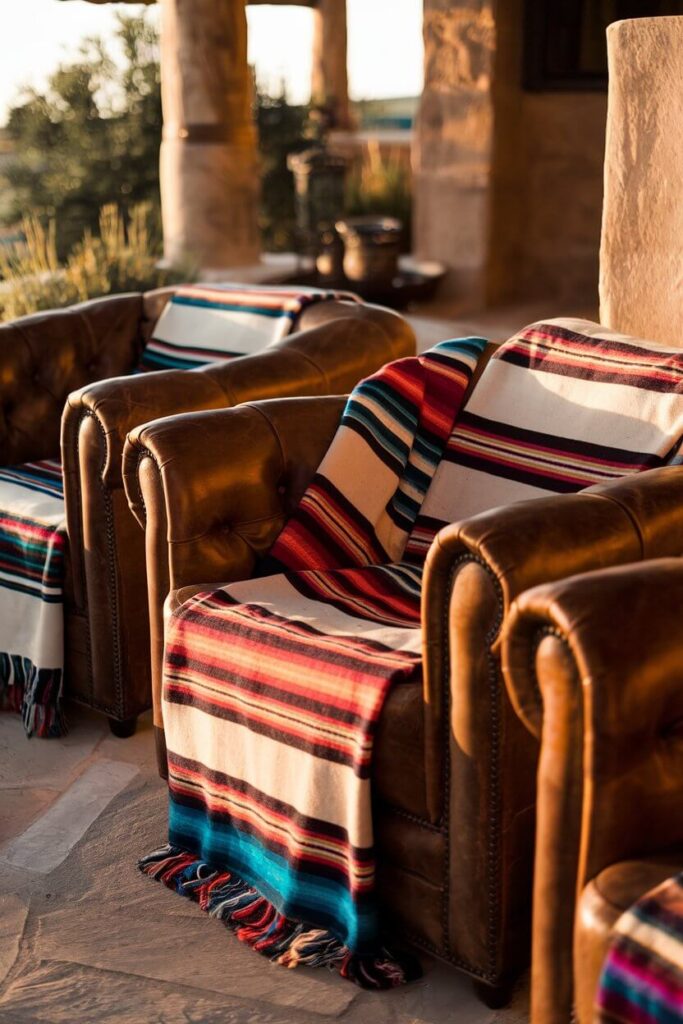
Layer your seating areas with genuine serape blankets featuring traditional striped patterns in vibrant colors. These handwoven textiles from Mexican artisans add instant warmth and cultural authenticity to any space.
Why it works: Serapes provide both practical warmth and visual interest while supporting traditional Mexican textile arts.
Best for: Sofas, chairs, bed throws, and outdoor seating where you want to add color and texture.
Pro implementation tip: Rotate serapes seasonally to prevent fading, and choose patterns that complement rather than compete with your room’s color scheme.
Potential drawback: Authentic serapes require gentle hand washing and may fade if exposed to direct sunlight for extended periods.
8. Oaxacan Wool Rugs
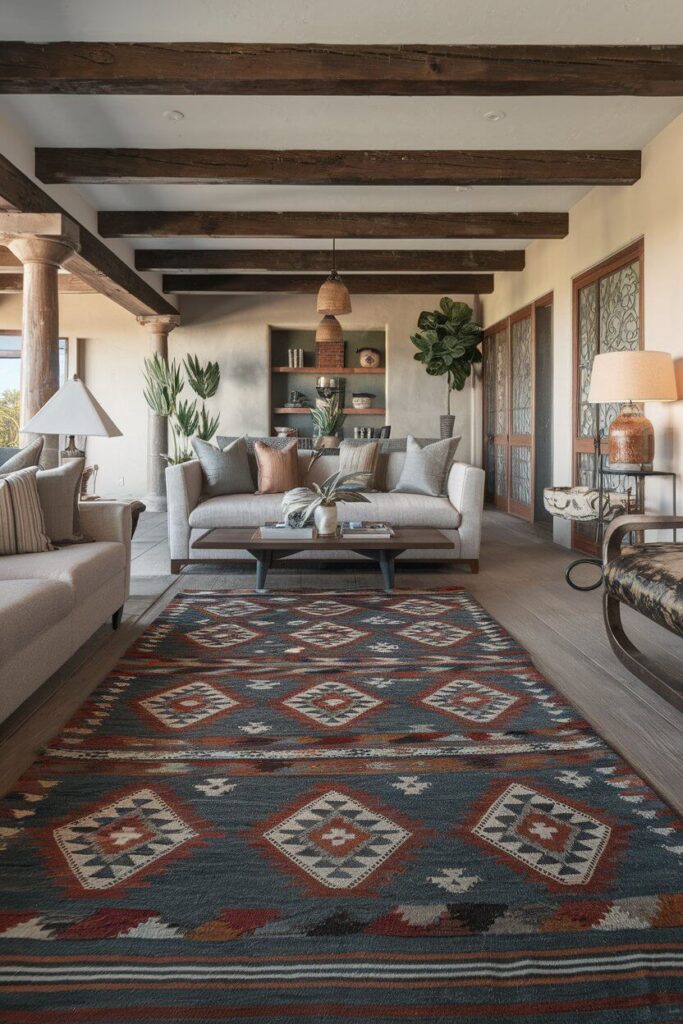
Ground your spaces with handwoven wool rugs featuring traditional Zapotec designs from Oaxaca. These rugs often incorporate natural dyes and ancient weaving techniques passed down through generations.
Why it works: Oaxacan rugs provide warmth, sound absorption, and cultural authenticity while showcasing incredible craftsmanship.
Best for: Living rooms, bedrooms, and dining areas where you want to define spaces and add textile interest.
Pro implementation tip: Choose rug sizes that extend at least 18 inches beyond your furniture arrangement to properly anchor the space.
Potential drawback: Handwoven wool rugs can be expensive and may require professional cleaning to maintain their appearance.
9. Embroidered Pillow Collections
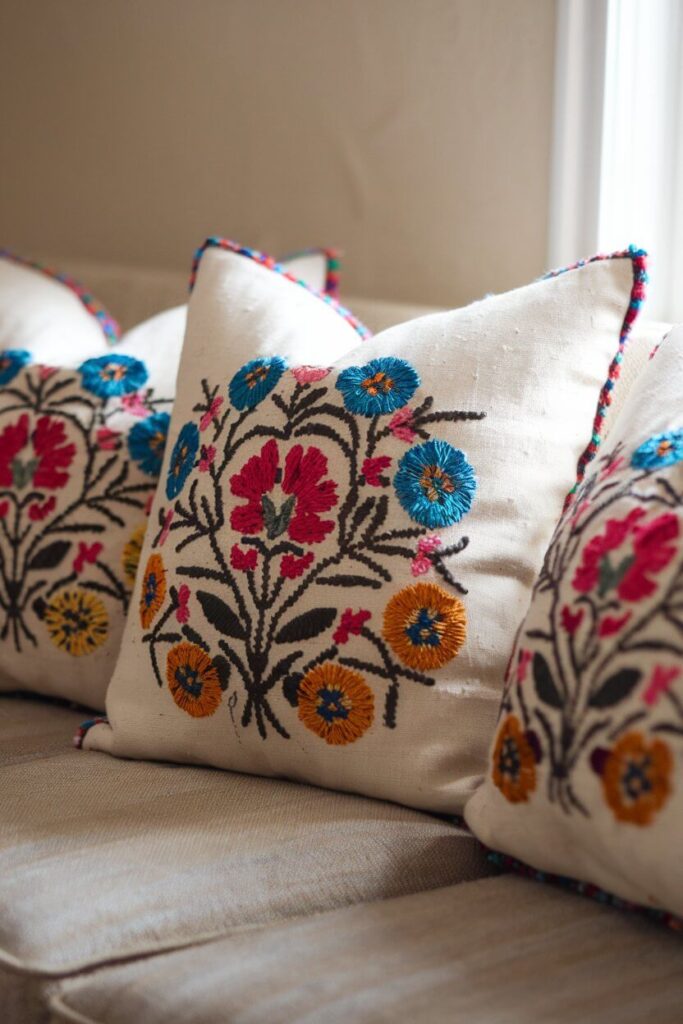
Mix and match pillows featuring traditional Mexican embroidery techniques like Otomí, Chiapas florals, or geometric patterns from different regions. Vary the sizes and shapes for the most dynamic arrangement.
Why it works: Embroidered pillows allow you to introduce Mexican artistry in small, affordable doses while adding comfort and color.
Best for: Sofas, beds, window seats, and outdoor furniture where you want to add pops of culture and comfort.
Pro implementation tip: Combine pillows of different textures—smooth cotton, nubby linen, and soft wool—for the most interesting tactile experience.
Potential drawback: Heavily embroidered pillows may be less comfortable for extended lounging and can show wear more quickly than solid fabrics.
10. Hand-Painted Window Treatments
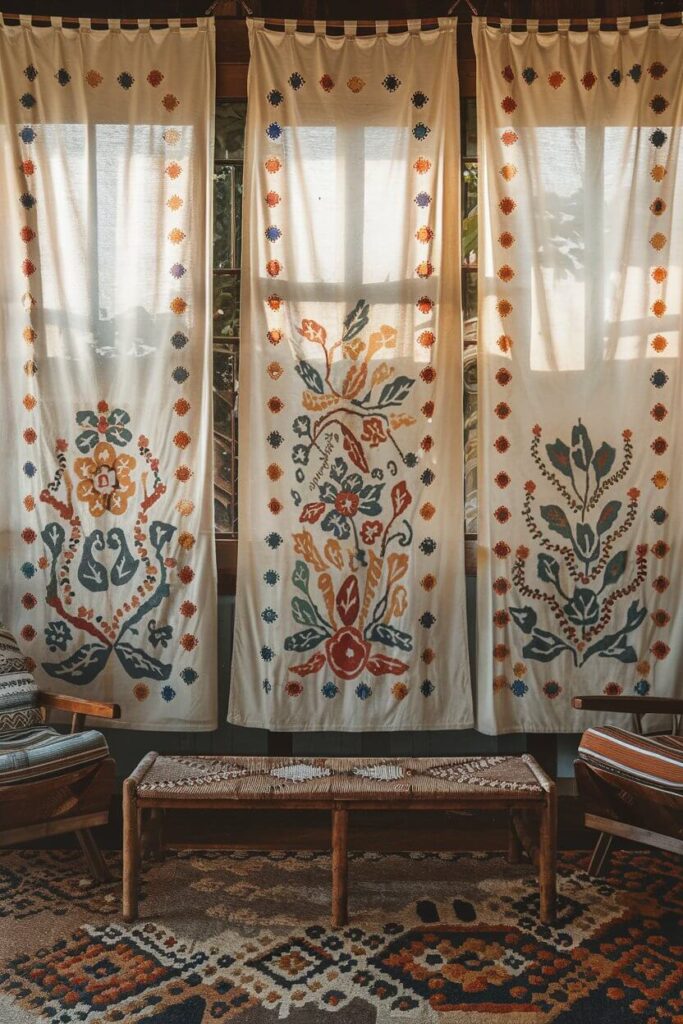
Replace standard curtains with hand-painted fabric panels featuring Mexican motifs, or install wooden shutters painted in traditional colors like deep turquoise or burnt orange.
Why it works: Custom window treatments allow you to control light while showcasing artistic elements that reflect Mexican folk art traditions.
Best for: Living rooms, bedrooms, and kitchens where you want to filter light while maintaining privacy and style.
Pro implementation tip: Layer sheer panels behind heavier painted curtains to provide flexibility in light control throughout the day.
Potential drawback: Hand-painted fabrics may fade more quickly than printed alternatives and often require professional cleaning.
Furniture and Storage Solutions
11. Rustic Pine Furniture Collections
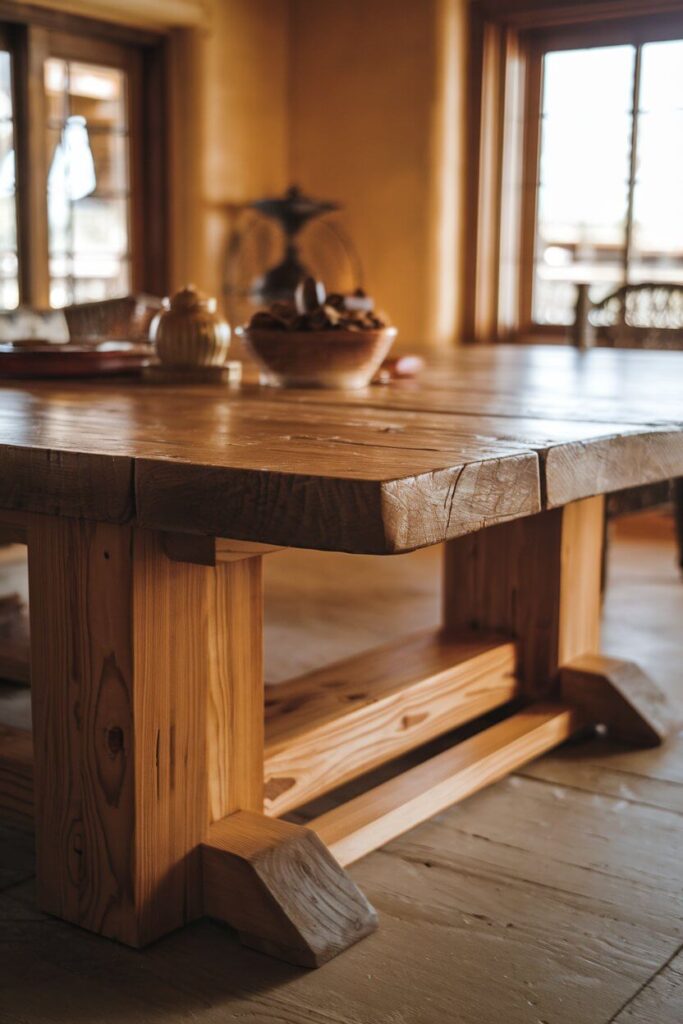
Invest in solid pine furniture pieces featuring traditional Mexican construction techniques like mortise and tenon joints, hand-carved details, and natural wax finishes that allow the wood’s character to shine through.
Why it works: Pine furniture provides durability and authenticity while developing a beautiful patina over time that adds to its rustic appeal.
Best for: Dining rooms, bedrooms, and living areas where you want substantial, long-lasting furniture with genuine Mexican character.
Pro implementation tip: Mix different wood tones within the same space to avoid a “furniture set” look that can appear too uniform.
Potential drawback: Solid wood furniture requires more maintenance than manufactured alternatives and can be susceptible to dents and scratches.
12. Equipal Chairs and Ottomans
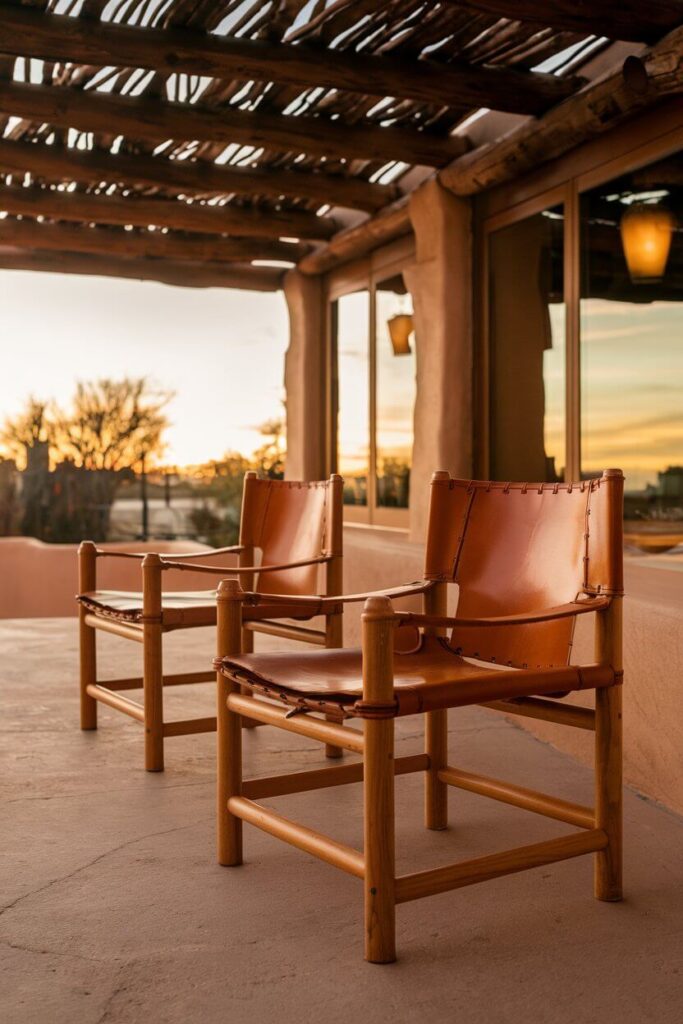
Add seating with traditional equipal furniture made from tanned pigskin stretched over cedar frames. These comfortable, flexible chairs are perfect for both indoor and outdoor use.
Why it works: Equipal furniture is incredibly comfortable, naturally flexible, and represents one of Mexico’s most iconic furniture styles.
Best for: Patios, sunrooms, living rooms, and anywhere you need casual, comfortable seating with authentic Mexican flair.
Pro implementation tip: Condition the leather annually with appropriate leather conditioner to prevent cracking and maintain flexibility.
Potential drawback: Leather furniture can be challenging for households with pets or young children, and it may retain odors in humid environments.
13. Hand-Carved Storage Chests
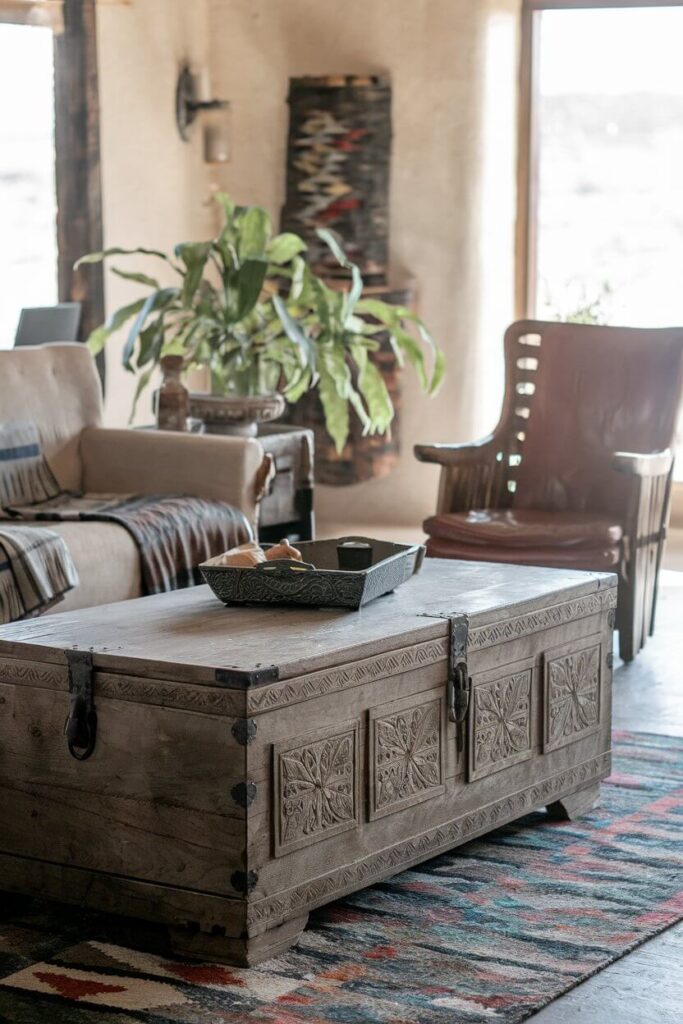
Incorporate wooden storage chests featuring traditional Mexican carving motifs for both function and decoration. These pieces can serve as coffee tables, end tables, or bedroom storage while showcasing incredible artistry.
Why it works: Carved chests provide hidden storage while serving as conversation pieces that demonstrate traditional woodworking skills.
Best for: Living rooms, bedrooms, and entryways where you need storage solutions that double as decorative elements.
Pro implementation tip: Use furniture pads on top of storage chests when using them as tables to protect both the wood and your belongings.
Potential drawback: Intricate carvings can collect dust and may require regular maintenance to preserve their appearance.
14. Painted Mexican Armoires
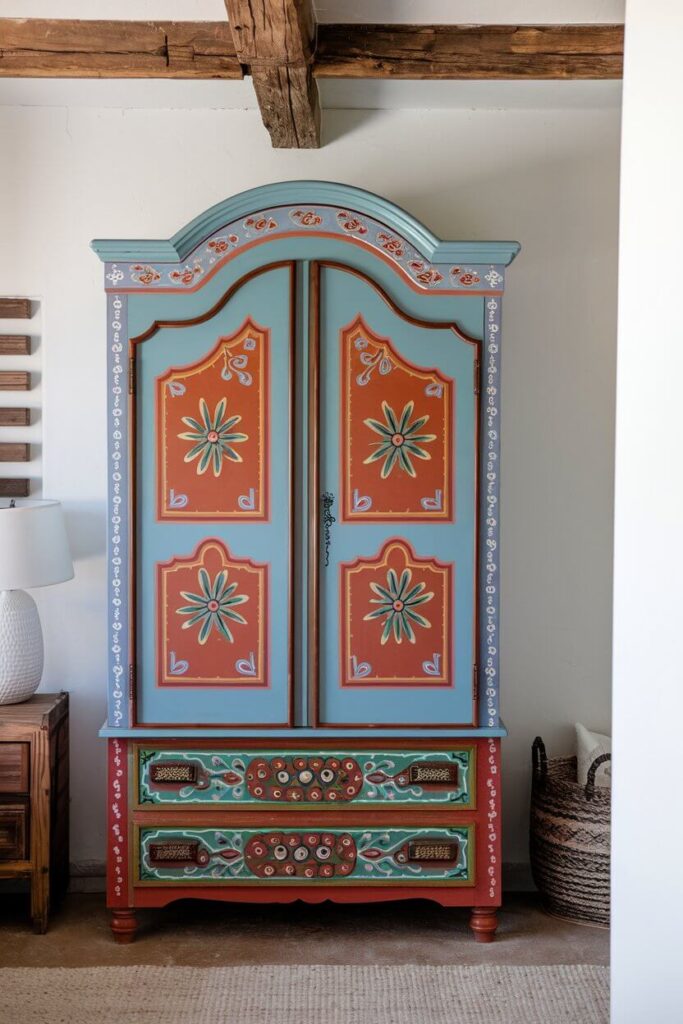
Transform storage needs with colorful painted armoires featuring folk art designs. These versatile pieces can house electronics, clothing, or serve as pantry storage in kitchens.
Why it works: Painted armoires add significant storage while serving as artistic focal points that can hide modern necessities like televisions and electronics.
Best for: Bedrooms, living rooms, and kitchens where you need substantial storage with authentic Mexican style.
Pro implementation tip: Ensure armoires have proper ventilation if using them to house electronics, and consider adding interior lighting for practical use.
Potential drawback: Large armoires can overwhelm small spaces and may require disassembly for moving or rearranging.
15. Rustic Dining Sets

Center your dining area around a substantial wooden table with matching benches or chairs featuring traditional construction methods and hand-finished details.
Why it works: A rustic dining set creates a natural gathering point that encourages longer, more relaxed meals in true Mexican tradition.
Best for: Dining rooms, breakfast nooks, and outdoor entertaining areas where you want to encourage social interaction.
Pro implementation tip: Protect wooden dining surfaces with placemats or a table runner, but avoid glass tops that hide the wood’s natural beauty.
Potential drawback: Rustic dining furniture may require more maintenance than contemporary alternatives and can show wear from daily use.
Lighting and Ambiance
16. Hand-Blown Glass Pendant Lights
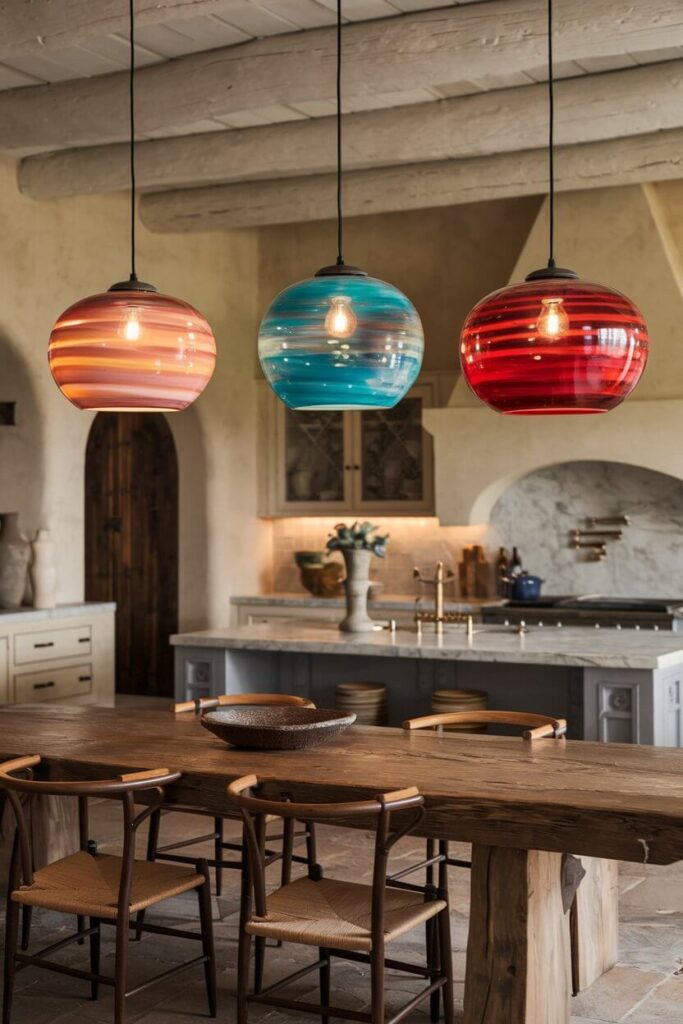
Illuminate your spaces with pendant lights featuring hand-blown glass in traditional Mexican colors like deep blue, amber, or clear glass with subtle imperfections that catch light beautifully.
Why it works: Hand-blown glass pendants provide both functional lighting and artistic interest while showcasing traditional Mexican glassmaking techniques.
Best for: Kitchen islands, dining areas, and entryways where you want to create focal points with practical lighting.
Pro implementation tip: Vary the hanging heights of multiple pendants for visual interest, but maintain at least 30 inches of clearance above dining surfaces.
Potential drawback: Hand-blown glass can be fragile and may be difficult to replace if damaged.
17. Wrought Iron Chandeliers
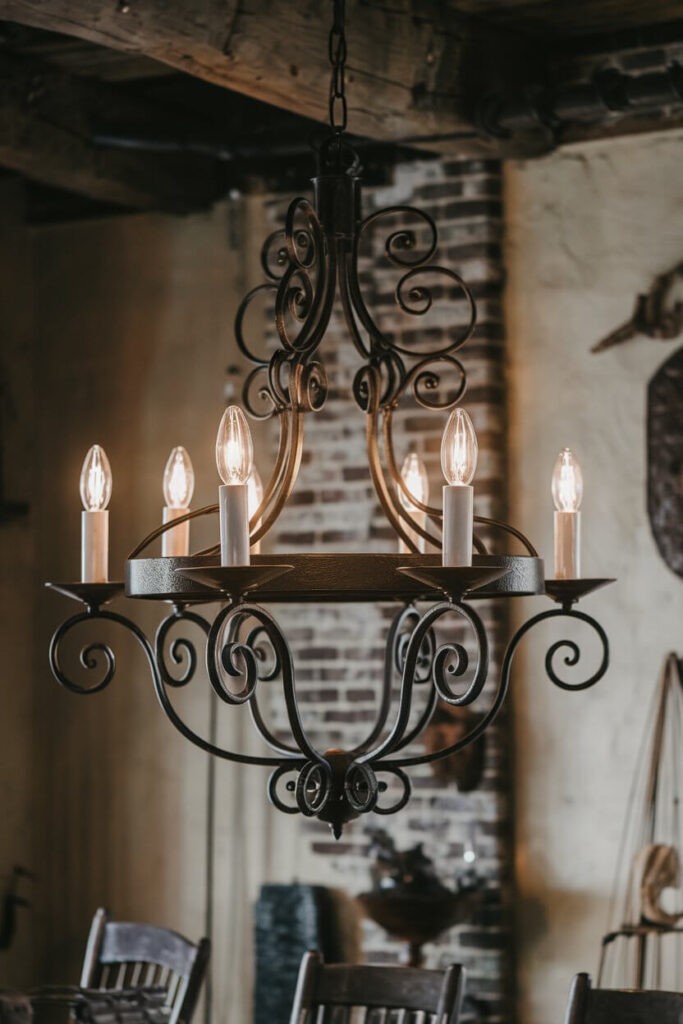
Create dramatic lighting with hand-forged wrought iron chandeliers featuring traditional scrollwork and candle-style bulbs that provide warm, ambient illumination.
Why it works: Iron chandeliers add architectural interest while providing ample lighting for dining and entertaining areas.
Best for: Dining rooms, entryways, and large living areas with high ceilings where you want to make a statement.
Pro implementation tip: Install chandeliers on dimmer switches to provide flexibility between bright task lighting and romantic ambient lighting.
Potential drawback: Heavy iron fixtures require proper ceiling support and professional installation to ensure safety.
18. Talavera Ceramic Sconces
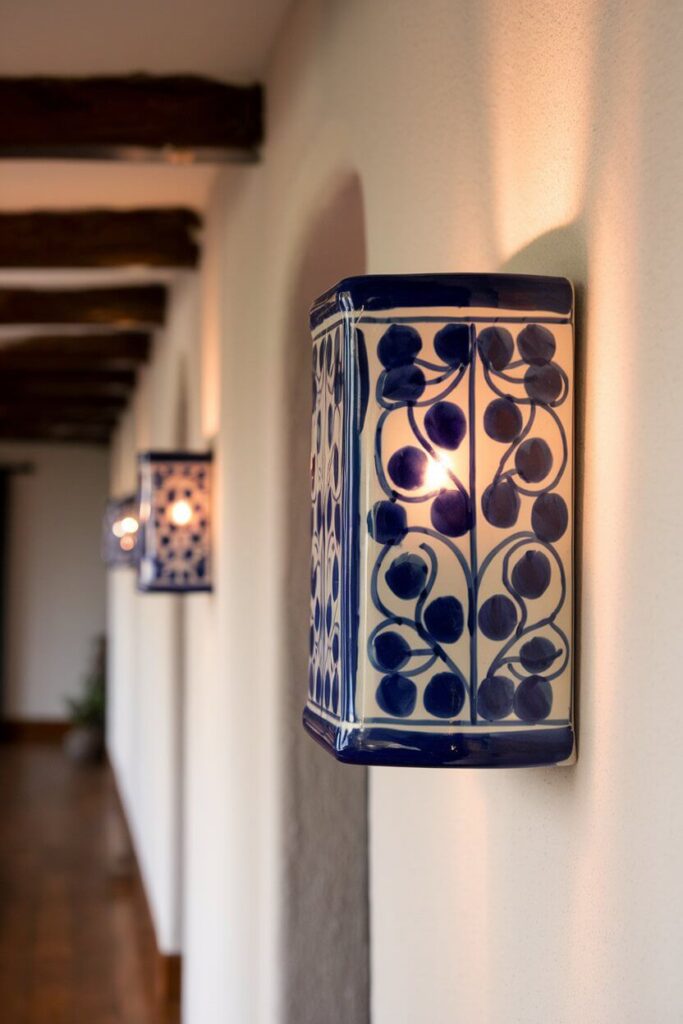
Mount hand-painted ceramic wall sconces featuring traditional Talavera designs for accent lighting that doubles as wall art. These fixtures provide gentle illumination while showcasing Mexican ceramic artistry.
Why it works: Ceramic sconces offer soft lighting while adding color and pattern to wall surfaces without requiring floor or table space.
Best for: Hallways, bathrooms, bedrooms, and outdoor covered areas where you want decorative accent lighting.
Pro implementation tip: Place sconces at eye level (approximately 60-66 inches from the floor) for optimal light distribution and visual appeal.
Potential drawback: Ceramic fixtures can be fragile and may be challenging to clean intricate painted details.
19. Tin and Glass Lanterns
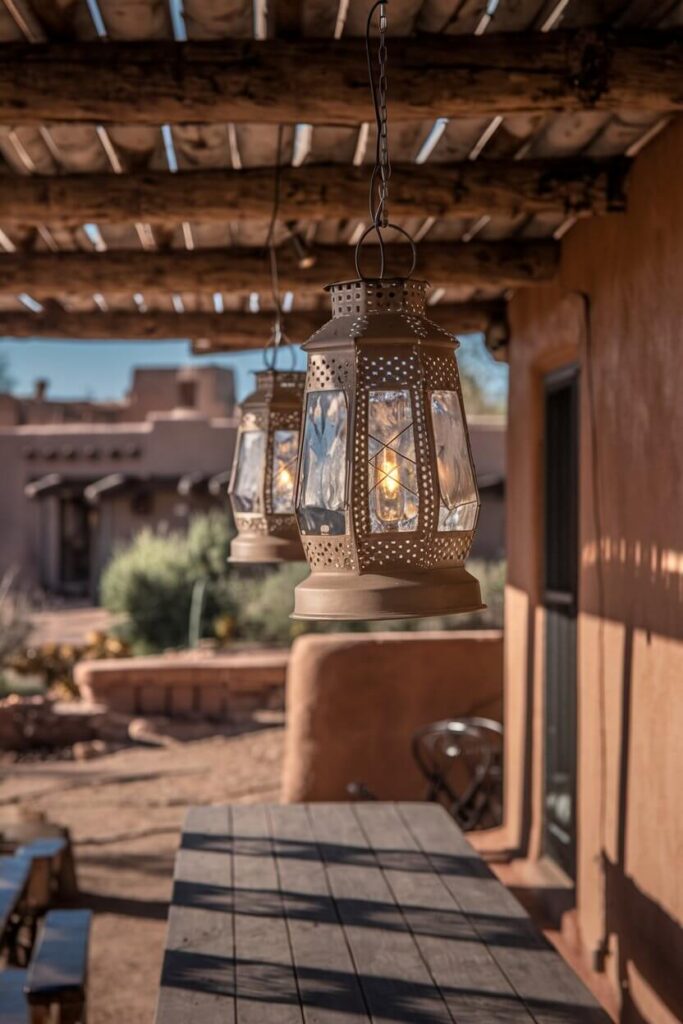
Incorporate punched tin lanterns with glass inserts for both indoor and outdoor lighting that creates beautiful shadow patterns when illuminated.
Why it works: Tin lanterns provide romantic, patterned lighting while representing traditional Mexican metalworking crafts.
Best for: Patios, dining rooms, bedrooms, and anywhere you want to create intimate, atmospheric lighting.
Pro implementation tip: Use LED candles or low-wattage bulbs to prevent overheating while maintaining the warm glow these fixtures are designed to provide.
Potential drawback: Punched tin can collect dust in the perforations and may require regular cleaning to maintain clear light patterns.
20. Rustic Wooden Candelabras

Display collections of pillar candles in carved wooden candelabras that can be arranged on mantels, dining tables, or sideboards for ambient lighting and decoration.
Why it works: Wooden candelabras provide flexible lighting options while showcasing traditional woodcarving skills and creating warm, inviting atmospheres.
Best for: Dining rooms, living rooms, and outdoor entertaining areas where you want to create romantic, intimate lighting.
Pro implementation tip: Always use dripless candles and place protective plates under candelabras to prevent wax damage to furniture surfaces.
Potential drawback: Open flames require constant attention and may not be suitable for homes with small children or pets.
Decorative Accents and Art
21. Talavera Pottery Collections
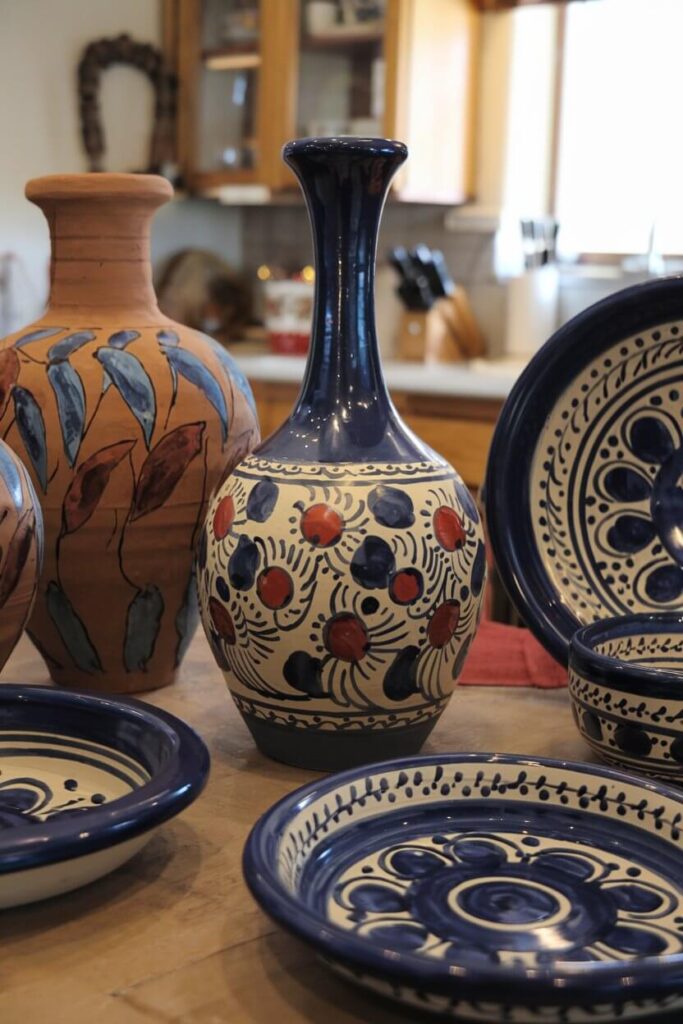
Display authentic Talavera pottery from Puebla, including vases, bowls, and decorative plates featuring traditional blue and white patterns or more contemporary colorful designs.
Why it works: Talavera pottery represents one of Mexico’s most refined ceramic traditions and adds sophisticated color and pattern to any space.
Best for: Kitchen open shelving, dining room displays, bathroom vanities, and anywhere you want to showcase authentic Mexican craftsmanship.
Pro implementation tip: Group pottery in odd numbers and vary heights for the most pleasing visual arrangements, mixing functional and decorative pieces.
Potential drawback: Authentic Talavera can be expensive and fragile, requiring careful handling and display consideration.
22. Mexican Folk Art Paintings
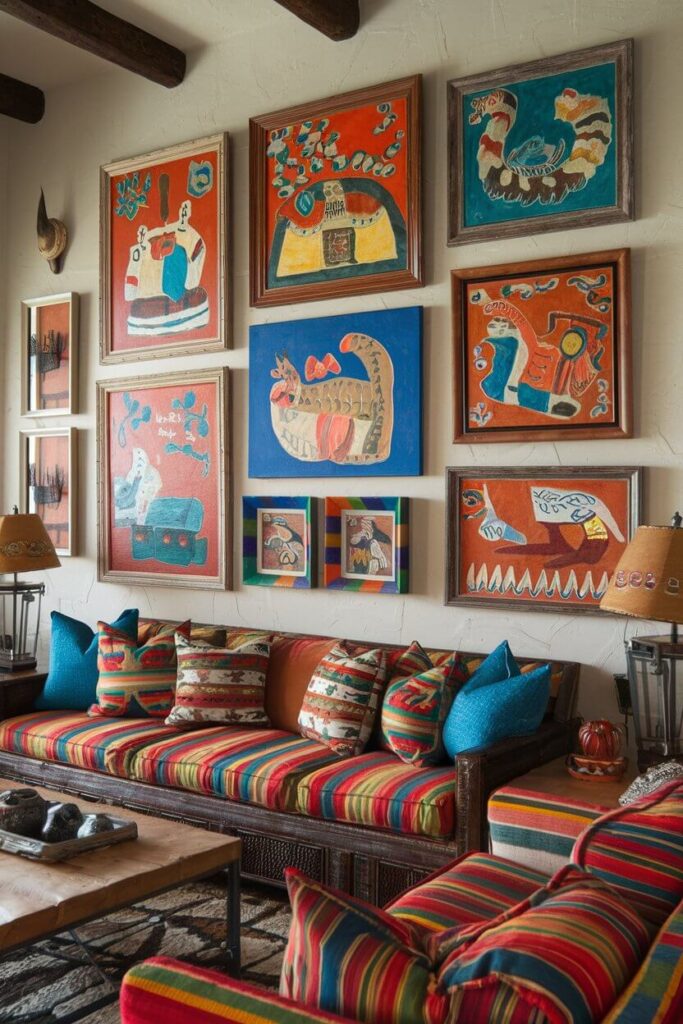
Hang original or high-quality prints of Mexican folk art, including landscapes, portraits, and traditional scenes that celebrate Mexican culture and artistic traditions.
Why it works: Folk art adds personal character while supporting Mexican artists and showcasing the country’s rich artistic heritage.
Best for: Living rooms, bedrooms, hallways, and dining areas where you want to create gallery-like displays of cultural art.
Pro implementation tip: Frame folk art in simple wooden frames that complement rather than compete with the artwork’s vibrant colors and details.
Potential drawback: Original folk art can be expensive, and prints may lack the texture and character of handmade pieces.
23. Hand-Carved Wooden Sculptures
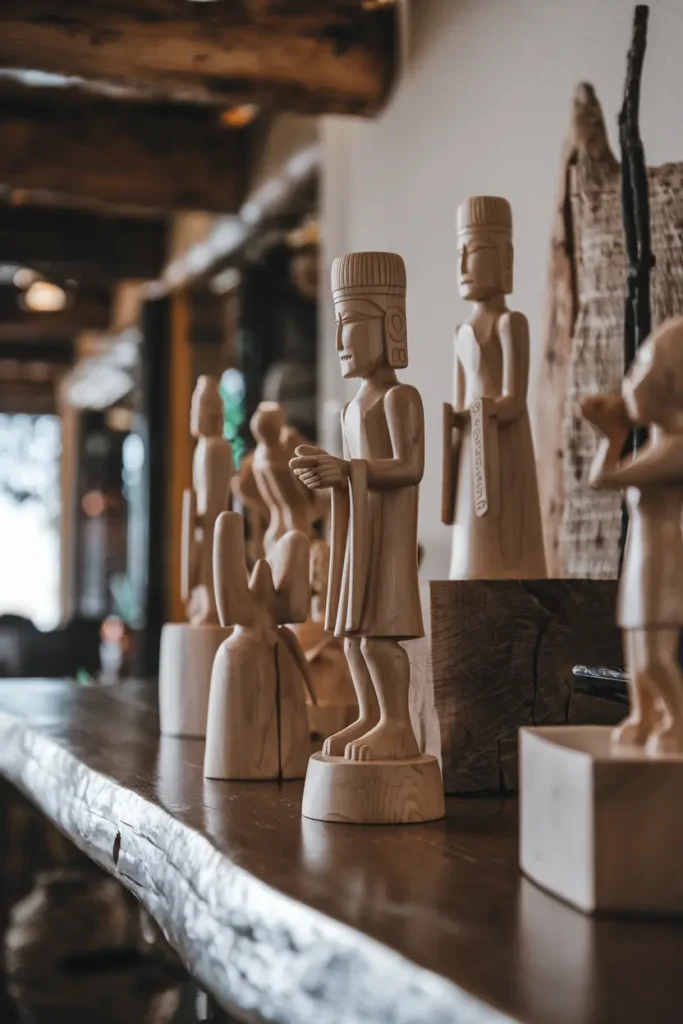
Incorporate wooden sculptures and figurines representing Mexican cultural symbols, animals, or religious imagery carved by traditional artisans.
Why it works: Wooden sculptures add three-dimensional interest while showcasing incredible carving skills and cultural symbolism.
Best for: Shelving displays, tabletop arrangements, and as standalone art pieces where you want to add sculptural interest.
Pro implementation tip: Dust wooden sculptures regularly with a soft brush to maintain their carved details and prevent buildup in intricate areas.
Potential drawback: Detailed carvings can be fragile and may require careful handling during cleaning or rearranging.
24. Milagros and Religious Art
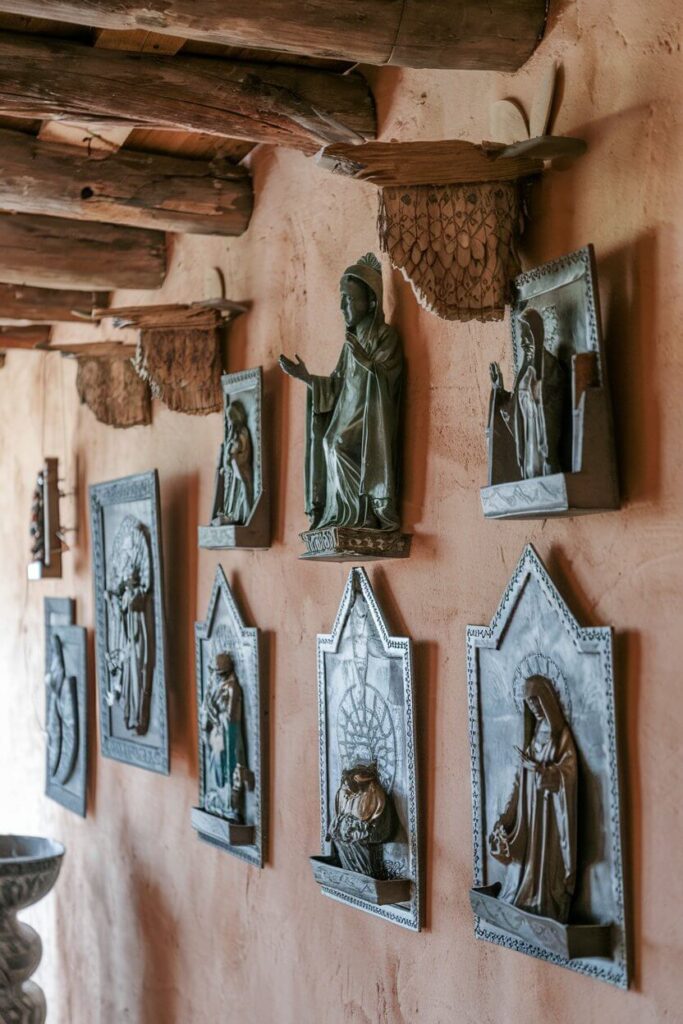
Display traditional milagros (small metal charms) or religious art pieces that reflect the spiritual aspects of Mexican culture, arranged respectfully as decorative elements.
Why it works: These pieces add cultural depth while representing the spiritual traditions that influence Mexican artistic expression.
Best for: Intimate spaces, bedrooms, meditation areas, or small wall arrangements where you want to add meaningful cultural elements.
Pro implementation tip: Research the cultural significance of religious symbols to ensure respectful display and appropriate placement in your home.
Potential drawback: Religious imagery may not be appropriate for all households or may require sensitive placement consideration for guests of different faiths.
25. Mexican Textile Wall Hangings
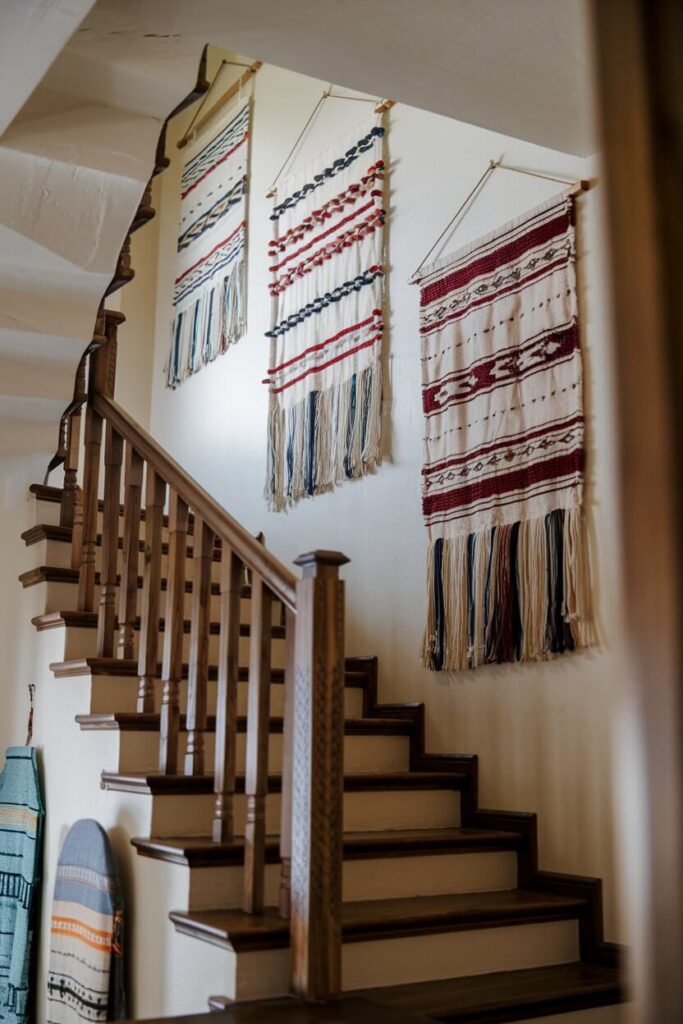
Transform blank walls with authentic Mexican textiles displayed as art pieces, including rebozos, huipiles, or specially woven decorative panels.
Why it works: Textile wall hangings add color, pattern, and cultural authenticity while showcasing traditional weaving techniques and regional variations.
Best for: Large wall spaces, staircases, bedrooms, and anywhere you want to create dramatic textile displays.
Pro implementation tip: Mount textiles on wooden dowels or in shadowboxes to prevent damage while allowing the full design to be appreciated.
Potential drawback: Textiles can fade if exposed to direct sunlight and may require professional cleaning to maintain their appearance.
Creating Cohesive Mexican-Inspired Spaces
The key to successfully implementing rustic Mexican décor lies in understanding balance and restraint.
Rather than incorporating every idea at once, choose elements that complement your existing architecture and lifestyle. Start with foundational elements like wall treatments or flooring, then layer in textiles, lighting, and accessories gradually.
Pay attention to color harmony by selecting a palette inspired by Mexican landscapes—warm terracottas, deep blues, sage greens, and golden yellows work beautifully together.
Natural materials like wood, stone, and clay should dominate, with metal accents providing contrast and sophistication.
Remember that authentic Mexican style celebrates imperfection and handmade character. Embrace slight variations in color, texture, and form rather than seeking perfectly matched sets. This approach creates spaces that feel collected over time rather than decorated all at once.
Budget-Friendly Implementation Strategies
You don’t need to invest thousands of dollars to achieve authentic Mexican style. Start with paint techniques and textile accessories that provide immediate impact for minimal cost. Scour local thrift stores, estate sales, and online marketplaces for authentic pieces that may need minor restoration.
Consider DIY projects like painting existing furniture in Mexican-inspired colors, creating your own tin lanterns, or sewing pillow covers from authentic fabrics. Many Mexican décor elements can be crafted at home with basic skills and creativity.
Focus your budget on one or two statement pieces—perhaps an authentic Talavera pottery collection or a hand-carved dining table—then support these investments with more affordable accessories and textiles.
Maintaining Your Mexican-Inspired Home
Natural materials and handmade items require different care than mass-produced furnishings. Wooden furniture benefits from regular conditioning with appropriate oils or waxes. Ceramic and pottery pieces should be handled carefully and cleaned with gentle, non-abrasive products.
Textiles may need professional cleaning or careful hand washing to maintain their colors and structural integrity. Rotate displayed textiles and artwork to prevent uneven fading from sunlight exposure.
Metal elements like wrought iron require periodic inspection for rust and may need protective coatings in humid environments. The investment in proper maintenance preserves both the beauty and value of authentic pieces.
Transform Your Home with Authentic Mexican Character
Rustic Mexican décor offers the perfect opportunity to create a home that feels warm, authentic, and deeply personal. By incorporating these 25 ideas thoughtfully and gradually, you’ll develop spaces that celebrate craftsmanship, cultural heritage, and the simple pleasure of surrounding yourself with beautiful, meaningful objects.
The beauty of this decorating style lies in its emphasis on authenticity over perfection. Every slightly uneven tile, hand-painted imperfection, and natural variation in wood grain contributes to an overall aesthetic that feels lived-in and loved.
This approach creates homes that become more beautiful with age, developing character and patina that mass-produced alternatives simply cannot match.
Start with one or two elements that speak to you most strongly—perhaps a stunning Talavera pottery collection or a hand-carved dining table—and build your Mexican-inspired space gradually. This approach ensures that every addition feels intentional and meaningful rather than overwhelming or clichéd.
Your home should tell your story while honoring the rich cultural traditions that inspire these decorating choices.
With patience, research, and respect for authentic craftsmanship, you can create spaces that transport you and your guests to the warmth and beauty of Mexico, no matter where you live.
Ready to begin your transformation? Choose one foundational element from this guide and take the first step toward creating your own Mexican-inspired haven. Remember, the most beautiful homes are created one thoughtful decision at a time.

